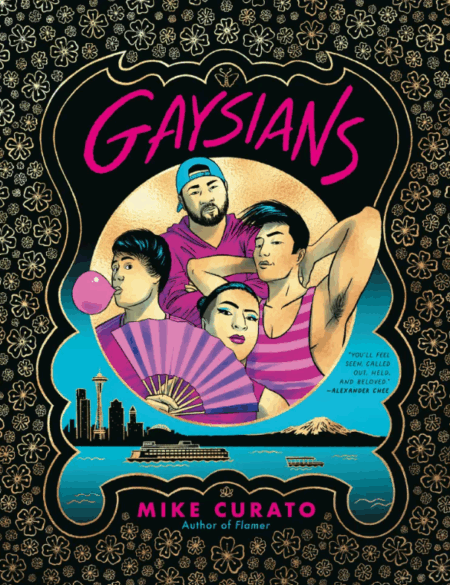
Juliet (Gabriella O’Fallon) and Romeo (Joshua M. Castille) are the fenced in young lovers in ACT’s ROMEO + Juliet onstage through March 31, 2019. Photo: Chris Bennion
Review: ROMEO + JULIET by William Shakespeare. Produced by ACT. Directed by John Langs. Fight Direction by Geoffrey Alm. Sign Master & ASL Translator: Ellie Savidge. Scenic Design by Skip Mercier. Costume Design by Pete Rush. Lighting Design by Robert Aguilar. Sound Design by Robertson Witmer. With Joshua M. Castille, Gabriella O’Fallon, Howie Seago, Lindsay W. Evans, Amy Thone, Darragh Kennan, Chip Sherman, Reginald Andre Jackson, Ryan Higgins, Mikey Florey, Chad Sommerville, Matthew Thomas Moore. Now through March 31, 2019 at ACT Theatre.
There are plays & musicals that challenge the theater critic…and, I’m not talking about ‘weird’ stuff in grungy basement theaters or experimental plays where the actors all play animals in a dystopic society.
Though those are usually a chore to sit through…
But, there are everyday works that are staged so frequently that you just can’t bear one more production. How many times must we endure yet another company doing Legally Blonde: The Musical? And, of course Shakespeare productions are very much over-produced because:
- Shakespeare is great
- Shakespeare plays are really old and in the public domain thus no fees and freely adaptable
- Actors LOVE Shakespeare even though a great many of them are ill-equipped to perform it
And, of the Shakespeare plays, there’s the dreaded favorites that get done a lot. A Midsummer Night’s Dream and Macbeth and the king daddy of them all, Romeo & Juliet. They’re all really terrific plays but one doesn’t necessarily need to see a production every year…especially bad ones. So, when ACT announced they were doing Romeo & Juliet last year, I know more than one theater writer rolled their eyes and sighed and wistfully thought to themselves “why can’t those two stupid Italian teenagers just commit suicide in the first 10 minutes of the play and spare us 2 and a half hours of a story we now know by heart?”
But, ACT also announced they were doing something a bit different with their new production; they were casting deaf actors and using American Sign Language throughout the play to tell the story of those crazy lovesick kids. And, that was enough to pull us back in…especially when they announced they were casting young Joshua Castille as Romeo and Howie Seago as Friar Lawrence, two deaf actors we’ve much admired in Seattle productions. Mr. Seago is based in the area but Mr. Castille is an out of towner who has appeared, with great success, in ACT’s production of Tribes a couple seasons back and then as Quasimodo in the 5th Avenue’s production of The Hunchback of Notre Dame last year.
So, a different telling of an often told tale can be a good way to breathe life into familiar stories and I’m happy to say that ACT’s production, onstage in their in-the-round Allen Theatre mostly manages to achieve that. ACT’s artistic director John Langs is directing here and he’s staged a lively and passionate production with a mostly tight ensemble of actors and some outstanding design elements. The use of sign language and of having hearing actors speak for the deaf characters has added a bit to the running time (it clocks in around three hours) and it does start to feel a bit long by the end (plus, we already know the story so well, there comes a time when you need it to wrap up…) but the charm of this production and the strong cast make up for that.
I’m not about to do a synopsis of Romeo & Juliet…if you’re so badly educated that you don’t know the story, then go wild on Wikipedia! In a nutshell, it’s a tale of star crossed teen lovers from opposing wealthy ruling families in “olden days” Verona Italy who fall in love and tragedy ensues. There’s some speculation that Shakespeare meant the opposing sides to represent what was going on in England in 1595 with the country still very much dealing with the Reformation of the Church, dividing the country between old school Catholics and new school Protestant/Anglicans where families and neighbors could be very much at war with one another. And, that’s where the use of deaf actors and the sign language helps this production achieve something unique with the deaf Romeo positioned as being an “other” something different from the rest which sets him off as a foil to the hearing world. Romeo’s family the Montagues are naturally all proficient with Sign Language while Juliet’s family, the Capulets, are not and are either hostile towards it, or in the case of Juliet and her Nurse, eager to learn.
I very much liked the use of deaf actors and Sign Language to tell this old tale in a compelling new way; it makes the story fresh again and gives it great energy and very much benefits the production for audiences eager for it but I have to question if this “Romeo + Juliet” is actually a working piece of deaf theater, and, I have to say: “Not Really”. I don’t know much Sign Language but I do know enough that you have to be able to SEE it, to understand it clearly. Since the Allen Theatre is an in-the-round theater space, it’s impossible to actually SEE all the sign language being performed. The energy of the signed performances is great for those who can also hear the performances and get the gist of what is being conveyed but if you’re a deaf person relying on the signed language to understand, that’s not going to happen here. (ACT does have an in-house captioning system as well as ASL interpreters at certain performances). So, while I think the use of ASL is very effective dramatically speaking, it’s not always a practical approach. It’s not really deaf theater; it’s theater that uses deaf characters in an interesting way but not always in a way that will necessarily benefit deaf audiences.
That said, it’s still a strong show that’s well staged by Mr. Langs with some riveting fight sequences, assisted by fight director Geoffrey Alm. And, the direction of the actors has led to some interesting revelations that allow characters to be showcased in ways I’ve never seen before. Lindsay Evans brought aspects to Lady Capulet that I’ve bothered to pay attention to in previous productions…she very much seemed like Juliet’s living/breathing and very much exasperated mother of a teenaged girl. And, for the first time, she’s an appropriately aged Lady Capulet who is supposed to have married herself when not much older than Juliet, thus around 29 or 30. It’s a fresh approach to a character who is actually important to the structure of the play.
The same thing applies to Chip Sherman’s Benvolio, Romeo’s cousin who usually just fades into the woodwork in so many productions. Here, because Benvolio must frequently give voice to Romeo’s words, he becomes an integral and vitally interesting character. It’s a refreshing take on the character and a lovely performance from Mr. Sherman.

Nurse (Amy Thone) and Juliet (Gabriella O’Fallon) are strong reasons to check out ACT’s ROMEO + Juliet onstage through March 31, 2019. Photo: Chris Bennion
As for Amy Thone’s rendition of the Nurse, Juliet’s loyal, dithery and affectionate lifelong nanny, it’s all scene stealing pleasure. Ms Thone is probably best known for perfectly played, understated and subtle performances on stages all over town but here she’s letting all the stops out to give a big, grand comedic performance that propels this production with huge amounts of energy. With her turban and hidden flask of liquid courage, it’s a bravado performance with just a hint of Angela Lansbury at her comedic best. If you’re still hesitant to see another production of Romeo & Juliet, then let Ms Thone’s wonderful performance be enough to lure you in to see this production.
Now, to the kids themselves…Joshua M. Castille is strong as the besotted young Romeo. There is a terrific energy and passion to the performance which is obviously mostly signed by the actor (though he briefly speaks at times). There is a slight tendency to overdo the “grabs his hair in despair” bit at times, an over reliance of a physical bit of acting that should have been curtailed by the director, but overall it’s a compelling performance that’s well matched if not exceeded by the very bold talents of young Gabriella O’Fallon as Juliet a rare case of an age appropriate actor actually playing the role. Ms O’Fallon, a recent high school graduate, dazzled us last year in Washington Ensemble Theatre’s The Nether playing a digital object of forbidden desire. Here, her Juliet is all fiery, passionate flesh and blood….it’s very much an energetic teenager dealing with things in only a way a teenager can (mis)handle them. From her pop music fueled entrance to her bittersweet final exit, it’s a performance of great strength and beauty.
The only actor a bit out of sync here is Darragh Kennan as the volatile Montague ally Mercutio a role normally cast as being approximate in age to Romeo and Benvolio, perhaps a bit older as a pushing 20 or so youth but here…well, obviously Mr. Kennan isn’t quite in that ball park. And, since none of the other characters are being portrayed by actors of drastically different ages relevant to their characters, it just feels very much “one of these things isn’t like the other!” and begs the question “why did we cast this part meant for a 20 year old with an actor old enough to be that character’s father?” (Especially when there are a dozen young actors in town who would be superb in this role; male and female). I know “suspension of disbelief” is what we’re supposed to subscribe to nowadays but casting an older actor in this role does skew the dynamics and energy of the scenes the character appears in; it all feels like “why is this middle aged guy hanging around these kids and huffing/puffing to keep up?” And, while Mr. Kennan is a very good actor, he’s not good enough to convince me he’s 20…or, 30. It’s odd casting and rather a flat performance.
Design wise, the show is very solid with an interesting use of fencing to create the locations, designed by Skip Mercier. And, the costumes are very good in this modern dress production with a terrific but subtle use of color (blues for Romeo/Montagues and reds/pinks for Juliet/Capulets) by costume designer Pete Rush.
To wrap up, this is a compelling and energetic production of Romeo & Juliet. The use of the deaf actors and Sign Language made an old story fresh again and the staging and design elements with the majority of the cast, all add up to a passionate and powerful production of a well worn tale. Highly recommended.

















